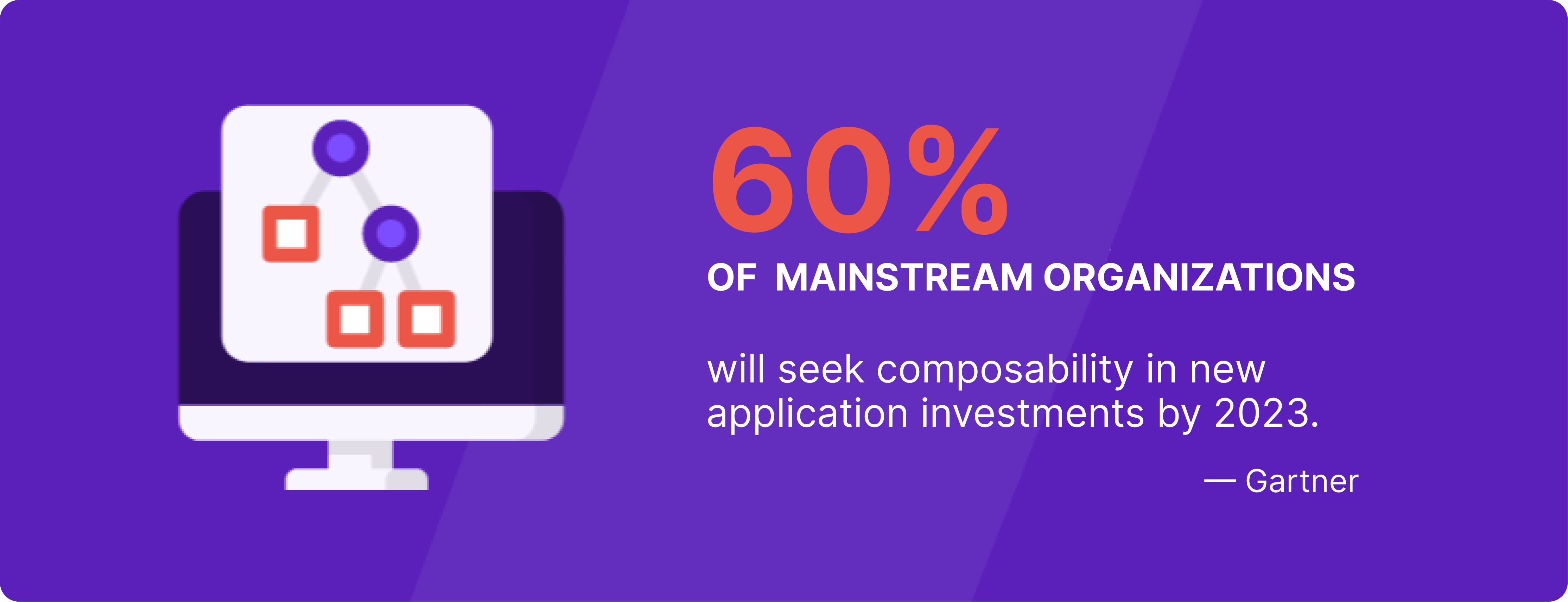Navigating DXP integration challenges for seamless operations

Navigating DXP integration challenges requires strategic planning. Learn how to address potential issues like data silos, legacy systems and security. Addressing these challenges enables you to streamline your integration process and improve performance.
Highlights
You’ll learn how to navigate DXP integration challenges for optimal performance:
- Data management: Install a customer data platform to consolidate data
- Security measures: Implement a unified security protocol and update compliances
- User experience: Design interfaces with users in mind
- Strategic planning: Create a clear roadmap and anticipate integration issues
Create seamless DXP integration, save time, and power business growth.
As customer needs become more dynamic, businesses must devise ways to keep up and exceed expectations. A DXP allows them to do that. With DXPs, brands can create and optimize digital experiences across multiple channels.
However, the integration may not go as planned. This often leads to wasted time and investment, technical debt, etc. So, how can they handle these issues?
Understanding DXP and its role
A digital experience platform (DXP) integrates various modules like personalization, analytics, CMS, and customer journey mapping to deliver engaging digital experiences. It provides a unified platform for a business to manage customer data and interactions. DXPs support innovation in many ways, such as:
- Delivers tailored content across channels.
- Integrates with existing martech stacks to streamline marketing efforts.
- Uses data analytics to support decision-making and improve ROI.
Benefits of DXP integration
A DXP enhances user and customer experience in the following ways:
- Consistent branding: When a DXP is well-integrated, brands can deliver consistent messaging across their digital channels.
- Aligns business and IT: It ensures that marketers and developers can work on the best solutions to deliver optimum user experiences.
- Seamless data flow: Systems can share data without disruption. That ensures that teams can collaborate better.
- Greater flexibility: Businesses can adapt to new trends by integrating new features on the go.

Common DXP integration challenges
When setting up a DXP, you may face minor setbacks. Ensuring you understand them will help you prepare to manage them.
Legacy system issues
Legacy systems usually form the bedrock of an organization’s business, making them difficult to modify or upgrade. This is usually because they have different data structures and underlying technologies.
Data silos
Data silos are stored data held by a business unit, often isolated from the rest of the organization. They create friction and inhibit innovation. Hence, it is essential to break them down and create a unified customer journey.
Stakeholder alignment
Aligning IT and business units is necessary for the success of DXP integration. As these are users and decision-makers, it can be difficult to align the needs of these different parties.
User adoption issues
DXP integration may change some business processes, which will affect system users. Hence, getting the team to key into the changes may require some work and a review of existing processes.
Security and compliance
Integrating new business tech can introduce security risks as attack surface areas increase. Each new solution may come with unique security needs. When you consider the number of services you need to integrate, it shows how much of an issue this can cause.
Start your free trial with Contentstack today. Transform your brand's digital presence with Contentstack's open MACH architecture and industry-leading technology. Witness a significant reduction in publishing and development time, and elevate your content management. Start your free trial now.
Strategies for seamless DXP integration
Now that you are clear on potential issues, how can you address them? Here are strategies you can start with.
- Create an integration plan: Outline the steps, timeline, and resources required for successful integration. Also, define clear objectives, identify users, and assign roles for each task.
- Leverage APIs: APIs facilitate the smooth exchange of data between the DXP and other systems. Use flexible, secure, and extensible APIs to integrate your apps.
- Migrate and consolidate data: Unify data from multiple sources to ensure you have a single source of truth. That way, you improve data accuracy and consistency. That also makes it easy to transfer data from legacy systems to the DXP.
- Align stakeholders: Take proactive steps to align decision-makers and users. Organize workshops and training sessions. Also, seek support from your DXP vendor to set up and manage the system.
- Leverage marketplace integrations: The Contentstack Marketplace offers apps and integrations that extend the functionality of your DXP, such as PIM, search, translations, etc.
Best practices for DXP implementation
Businesses must follow best practices to ensure the system’s long-term sustainability.
- Align business goals with DXP: Ensure that the DXP features align with and support your business goals.
- Conduct system audits: Audit your current system. Watch out for any issues with security, data structure, etc. Note areas that a DXP can improve.
- Prioritize user experience and map the customer journey: Design the DXP with the needs of customers in mind. Also, map the customer’s journey to identify their exact needs and the touchpoints they prefer. This enables you to optimize each channel.
- Set up robust security: Ensure that security certificates and compliances are up-to-date. Also, implement single sign-on (SSO), roles and permissions, access controls, etc., for better security.
- Be agile: Focus on an approach that allows you to test, iterate and push changes. This allows you to get the right feedback to improve the system on a regular basis.
Case studies
Ebner Media Group
Ebner Media Group was looking to reach a wider audience. They also wanted to reduce development resources and time. Many of their websites were powered by WordPress, which was difficult and time-consuming to update and maintain.
In response to these issues, they switched Contentstack's DXP. The headless CMS allowed them to reduce developer resources and scale effortlessly. It also enabled them to localize content and improve their reach, creating license-driven content at a global scale.
Hear from Álvaro Ruiz, the Head of Technology. “Partners pay for the license, and we can easily translate content with AI, allowing people to access the digital magazine globally. We’ve launched in Europe and Germany, and the plan is to expand into America, then Mexico, and keep going from there.”
Read more about how Ebner Media scaled digital publishing with Contentstack.
Technical Safety BC
Technical Safety BC had an old website with over 3000 pages, many of which were orphaned. The CMS was siloed, leading to inconsistent brand messaging. They reached out to Contentstack for solutions.
Contentstack's composable DXP enabled them to increase speed by 150 times, the page count was reduced by 60%, and web traffic grew by 73%. Its content creators also developed a structured framework, allowing them to create and deliver consistent brand messaging.
Hear from Ian Colvin, the Leader of Communications and Digital Experience.
“The new structure and consistency across the site has enabled our teams to easily find what they need when they are helping clients locate information on our site,”
Read the case study here.
Maximizing ROI from DXP integration
Studies show that personalization can drive revenue growth by up to 15%. But how would you know the impact of your DXP integration? Here are a few pointers.
Measure KPIs: Track performance metrics to evaluate the success of the DXP integration. This allows you to know the impact of the DXP integration, as well as identify areas that could use improvement.
Continuous optimization: Set up periodic reviews and optimize the DXP to ensure it evolves with new trends. This enhances its performance and maximizes ROI.
Offer omnichannel experiences: Brands that implement an omnichannel strategy grow sales by 494%. So, ensure that your customers can move across multiple channels without disruption. This leads to ROI gains.
Future trends in DXP integration
Looking into the future, notable tech trends will continue to shape digital experience integration. Here are a few to consider.
- Headless and composable: Gartner says 70% of organizations will implement composable architecture by 2026. This will give businesses more flexibility and allow them to reach customers on multiple platforms.
- Integration with IoT, AR/VR: These tech solutions offer untapped opportunities for enhancing customer experiences. They will support real-time data collection, immersive experiences, and personalized experiences.
- Cloud-native DXP solutions: Cloud-native DXPs will be built and deployed in the cloud. That will equip them with adequate resources that will support scaling and business growth.
Contentstack: Your partner in scaling digital experiences. Twice named a Leader in Forrester's composable DXP award, Contentstack offers an innovative approach to DXP. Experience our 100% microservices architecture and API coverage that allows instant scalability. Start your free trial today.
FAQ section
What are the core capabilities of DXP?
A DXP offers various features, such as customer data, content strategy, analytics, content management, personalization, etc.
What is a DXP strategy?
A DXP strategy is the complete approach with which a brand plans, implements, and optimizes a DXP to deliver seamless digital experiences to its customers.
What are the benefits of DXP?
A DXP improves customer engagement, enhances decision-making, and contributes to revenue growth.
What does DXP stand for?
DXP stands for digital experience platform.
Learn more
Successful DXP integration requires a strategic approach to address potential challenges and leverage best practices. These strategies equip you to manage issues with legacy systems, data silos, change, or security.
Start with an integration plan and leverage APIs. Consolidate and migrate data to address any data-related issues, get stakeholder buy-in, and prepare your team. Finally, implement a phased approach. That way, you reduce potential disruptions and give your team adequate time to adjust.
Contentstack offers a composable DXP with extensible APIs, headless CMS, and marketplace integrations to enable you to build the platform of your dreams. Its enterprise-grade security and robust technical support ease your setup and integration. Start your composable journey today with Contentstack. Talk to us today!
About Contentstack
The Contentstack team comprises highly skilled professionals specializing in product marketing, customer acquisition and retention, and digital marketing strategy. With extensive experience holding senior positions at renowned technology companies across Fortune 500, mid-size, and start-up sectors, our team offers impactful solutions based on diverse backgrounds and extensive industry knowledge.
Contentstack is on a mission to deliver the world’s best digital experiences through a fusion of cutting-edge content management, customer data, personalization, and AI technology. Iconic brands, such as AirFrance KLM, ASICS, Burberry, Mattel, Mitsubishi, and Walmart, depend on the platform to rise above the noise in today's crowded digital markets and gain their competitive edge.
In January 2025, Contentstack proudly secured its first-ever position as a Visionary in the 2025 Gartner® Magic Quadrant™ for Digital Experience Platforms (DXP). Further solidifying its prominent standing, Contentstack was recognized as a Leader in the Forrester Research, Inc. March 2025 report, “The Forrester Wave™: Content Management Systems (CMS), Q1 2025.” Contentstack was the only pure headless provider named as a Leader in the report, which evaluated 13 top CMS providers on 19 criteria for current offering and strategy.
Follow Contentstack on LinkedIn.







.svg?format=pjpg&auto=webp)
.svg?format=pjpg&auto=webp)
.png?format=pjpg&auto=webp)






.png?format=pjpg&auto=webp)


